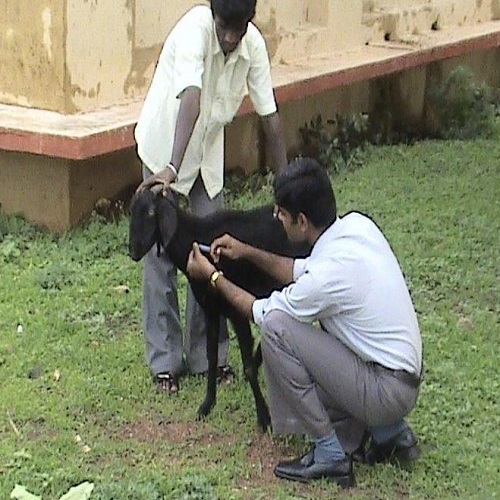Goat Diseases and Health Care Management
Generally goats are resistant to many diseases. However, when we rear more number of animals in one place and insufficiency of pasture facilities, intensive system of rearing leads to spread of many diseases. This causes reduced production potential and more mortality which in turn causes economic losses to the farmers. Hence, identification of diseases in goat and its prevention is most important.
Health management is more important especially worm load. Hence, the kids must be dewormed as mentioned in the Table below. Ecto-parasites must be treated carefully because it not only affect the growth but also affect skin quality.
Common Diseases, Vaccination and Deworming Schedule
| Disease | Age at vaccination | Periodicity of vaccination |
|---|---|---|
| Enterotoxaemia | > 4 months | Biannual (January and July) |
| Foot & Mouth Disease (FMD) | > 4-6 months | Biannual (Feb/March and August/September) |
| Black quarter | > 4-6 months | Annually (March/April) |
| Hemorrhagic septicemia | > 4-6 months | Annually (April/May) |
| Anthrax | > 6 months | Annually (April/May or in affected areas) |
| Peste des petits ruminants (PPR) | > 4 months | Annually (June/July) |
| Blue tongue | > 4-6 months | Annually (August) |
| Pox | > 4 months | Annually (December) |
| Deworming | • 15-20 days after birth | |
| • Every two months for the first year • Thrice a year (April, July and November) • Repeat deworming as required. |
||
Disease Management
- Be on the alert for signs of illness such as reduced feed intake, fever, abnormal discharge or unusual behavior.
- Consult the nearest veterinary aid centre for help if illness is suspected.
- Protect the animals against common diseases.
- In case of outbreak of contagious diseases, immediately segregate the sick animals from healthy one and take necessary disease control measures.
- Deworm the animals regularly.
- Examine the faeces of adult animals to detect eggs of internal parasites and treat the animals with suitable drugs.
- Provide clean and uncontaminated feed and water for minimizing the health disorders.
- Strictly follow the recommended vaccine schedule.

Vaccination in goats

Deworming
| Disease | Symptoms | Prevention |
|---|---|---|
| BACTERIAL DISEASES | ||
| Anthrax | Sudden fever and death, dark color bloody discharge from the natural orifice such as nose, anus and vagina | • Vaccination once in a year in affected area, • disposal of carcass either by burying or burning • don’t open the carcass as the germ spread through air |
| Haemorrhagic Septicemia | Fever, dysentery, swelling of lower mandible and death, More occurrence in rainy season | Vaccinate the animal once in a year before onset of rainy season |
| Brucellosis | Abortion during late pregnancy, infertility, scrotal swelling in male, joint swelling | • Disposal of dead foetus and placenta • Use gloves while handling infected items as it affect human beings |
| Enterotoxaemia | Sudden death in young growing kids, Mucous diarrhea is also seen during death | • Vaccinate the animals once in a year before the onset of monsoon • Don’t feed on young grass |
| Pneumonia | Fever, respiratory distress, mucous discharge from nostril, reduced feed intake and weight gain, cough | Clean water, well ventilated house |
| Foot rot | Wound in foot region | Keep the animal in dry clean house |
| Mastitis | Swelling of udder, change in milk | • Clean the shed • wash the udder with disinfectant solution |
| VIRAL DISEASES | ||
| Peste Des Petits Ruminants (PPR) | Fever, Occular and nasal mucous discharge, mouth lesion, respiratory distress | • Yearly vaccination • Separation of infected one from healthy animals |
| Foot and Mouth Disease | Fever, wound lesion in foot and mouth, excess salivary secretion, difficult in walking | • Follow regular vaccination as per the schedule • Isolate the affected animal from the healthy animals |
| Goat pox | Fever, Occular and nasal mucous discharge, respiratory distress, pox lesion in un hairy parts such as lips, thigh udder etc | • Follow regular vaccination as per the schedule • Isolate the affected animal from the healthy animals |
| Endo-Parasitic Diseases | ||
| Fluke infection | Emaciation, anaemia, edema in lower jaw | • Control of snails, • Avoid grazing in early morning and late evening, • Deworming of animals periodically |
| Tape worm | Reduced growth, fever, kid mortality | • Deworming of animals periodically |
| Round worm | Fever, anaemia, edema in lower jaw, reduced growth | • Deworming of animals periodically |
| Coccidiosis | Blood tinged brownish diarrhea, anaemia, kid mortality | • Clean house • spray of 10% ammonia solution, • administration of anticoccidial drugs |
| Ecto-Parasitic Infestation | ||
| Tick, lice etc | Reduced growth, skin allergy and wound | • Clean house, periodical dipping |

